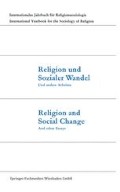Abstract
In his introductory discussion on ideology and utopia K. Mannheim has made an interesting remark. Namely, he has written that there are evidently some historical points “where the movement of life itself, especially in its greatest crisis, elevates itself above itself and becomes aware of its own limits” 1, pointing out that the historical course of social life is not located in a more or less homogenous, equally distributed social time and that the movement of social life arranges sometimes such historical situations that clearly show the inherent nature of some important social phenomena and make almost palpable the deep-going consequences of some social structures. This remark may be turned into a general statement that there are privileged historical situations and privileged social circumstances — particularly of deep crisis, very complex and extended, extremely dynamic and highly open and problematic in possible outcomes — that make clearly visible some very important characteristics of some social phenomena that in other circumstances remain hidden and unvisible. Such historical situations are very relevant to test the scope and adequacy of different theoretical approach to some important phenomena that belong to human social world.
Access this chapter
Tax calculation will be finalised at checkout
Purchases are for personal use only
Preview
Unable to display preview. Download preview PDF.
References
T. W. Adorno, Neutralized religion and its functions, in: Sociology and religion, Englewood Cliffs 1969, p. 338.
E. Fromm, Psychoanalysis and religion, p. 28/29, quoted in: H. Carrier, E. Pin, Essais de sociologie religieuse, Paris 1967, p. 265.
S. Buvar, Socioloiki presjek jugoslavenskog drustva (A sociological survey of the Yugoslav society), Zagreb 1970, str. 44.
M. Weber, Wirtschaft und Gesellschaft, Tübingen 1947, S. 815. For the history of the relations between the state and the Catholic Church see: Z. Roter, Katolicka crkva i drzava u socijalistickoj Jugoslaviji (The Catholic Church and the state in socialist Yugoslavia), in: Pogledi, 2/1970/4–5, str. 95–114.
N. Greinacher, La concezione del mondo della teologia cattolica dal punto di vista della sociologia della conoscenza, In: Rivista internazionale di dialogo, 2 (1969) 2, pp. 50–52.
A. W. Gouldner, The Coming crisis of Western sociology, New York 1970, p. 7.
J. Pascual, Das Ende der Ideologien, In: Neue Deutsche Hefte (1955), S. 592.
See: K. Rahner, Marxistische Utopie und christliche Zukunft des Menschen, In: Garaudy, Metz, Rahner, Der Dialog, Reinbek bei Hamburg 1966, S. 9–26, and J. M. Gonzales-Ruis, Il Cristianesimo non e un umanesimo, Assisi 1968, p. 30.
M. Kerievan, Nekateri aspekti odnosa urbanizacija — tradicionalna religiosnost (Some aspects of the problem urbanization and the traditional religiosity) 1971, str. 3 (Mimeographed paper presented at IV Annual Meeting of the Yugoslav Association of Sociology).
S. Bahtijarevié, Socijalistiéko drultvo, crkva i religija (The socialist society, Church and religion), Zagreb 1969, str. 20. For empirical data describing the religious situation in Yugoslavia see also: B. Bolnjak. S. Bahtijarevié, Porodica u transformaciji — crkva, religija (The family in transformation — Church and religion), Zagreb 1970, str. 212+ 25+ VXI (with English summary); Z. Roter, Socialisticna druzba in religija (The socialist society and religion), In: Izbor socioloskih razprav, Ljubljana 1970, str. 189–205; M. Tavear, Mladi in religija (The Youth and religion), In: op. cit., str. 214–222; E. Cimie, Socijalistiéko drustvo i religija (The socialist society and religion), Sarajevo 1966, str. 335; S. Vrcan, Religioznost splitskih srednjoskolaca i studenata (The religiosity of the high schools pupils and university students in Split), In: Skolski vjesnik, 19 (1969) 5–6, str. 28–52; Z. Roter, Znaeaj in struktura (ne) religioznosti u Sloveniji (The importance and the structure of [non] religiosity in Slovenia), In Teorija in praksa, 6 (1969) 4, str. 560–582; Z. Roter, Vloga Cerkve in javno mnenje (The Role of the Church and the public opinion), In: Teorija in praksa, 6 (1969) 5, str. 808–820; M. Kerlievan, Religioznost in druzbenopolitiena staliséa (The religiosity and political opinions), In: Teorija in praksa, 6 (1969) 2, str. 307–321; M. Tavear, Nekatera zapaznja in premisljanja o religiji na vasi (Some observations and considerations about the religion in rural areas), In: Problemi (1967) 50; Z. Mlinar, Verska aktivnost in tradicija na vasi (Religious activity and tradition in villages), In: Problemi (1967) 50; R. Lesnik, Nedeljniki v ljubljanski nadlkofiji (Sunday church-goers in the province of Ljubljana Archbishop), In: Cerkev v sedanjem svetu (1967).
Industria e religione, Brescia 1969, p. 429.
For the same phenomenon in the Soviet Union see: A. S. Klibanov, Nauclnoorganizacionnyj i metodiceskij opyt konkretnyh issledovanij religioznosti, In: Konkretnye issledovanija sovremennyh religioznyh verovanij, Moskva 1967, str. 12/13.
K. Marx, F. Engels, Werke, Bd. 1, Berlin 1961, S. 378. It is interesting to compare Marx’ approach in „Zur Kritik der Hegelschen Rechtsphilosophie“ with the approach in O. Klohr, op. cit.
D. M. Aptekman, Pri6iny zivucesti religioznogo obrjada krescenija v sovremennyh uslovijah, In: Voprosy filosofii (1965) 3, str. 89.
ObMestvo i religija, Moskva 1967, str. 476. The same is visible in: L. N. Mitrohin, O metodologii issledovanij sovremennoj religioznosti, In: Konkretnye issledovanija sovremennyh verovanij, str. 48/49.
Rights and permissions
Copyright information
© 1971 Springer Fachmedien Wiesbaden
About this chapter
Cite this chapter
Vrcan, S. (1971). Some Theoretical Implications of the Religiosity as a Mass Phenomenon in a Contemporary Socialist Society. In: Religion und Sozialer Wandel Und andere Arbeiten / Religion and Social Change And other Essays. Internationales Jahrbuch für Religionssoziologie / International Yearbook for the Sociology of Religion, vol 7. VS Verlag für Sozialwissenschaften, Wiesbaden. https://doi.org/10.1007/978-3-663-01713-4_8
Download citation
DOI: https://doi.org/10.1007/978-3-663-01713-4_8
Publisher Name: VS Verlag für Sozialwissenschaften, Wiesbaden
Print ISBN: 978-3-663-01714-1
Online ISBN: 978-3-663-01713-4
eBook Packages: Springer Book Archive

